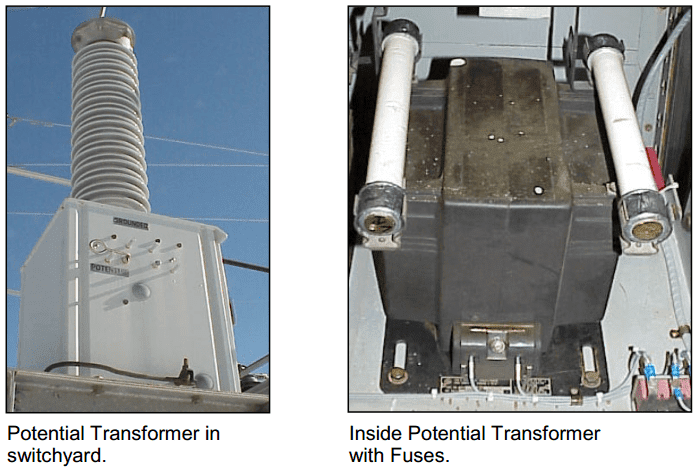Potential Transformers
Potential transformers (Picture 1) are used with voltmeters, wattmeters, watt-hour meters, power-factor meters, frequency meters, synchroscopes and synchronizing apparatus, protective and regulating relays, and undervoltage and overvoltage trip coils of circuit breakers. One potential transformer can be used for a number of instruments if the total current required by the instruments connected to the secondary winding does not exceed the transformer rating. Potential transformers are usually rated 50 to 200 volt-amperes at 120 secondary volts. The secondary terminals should never be short circuited because a heavy current will result, which can damage the windings.
Picture 1: Potential Transformers
Current Transformers
The primary of a current transformer typically has only one turn. This is not really a turn or wrap around the core but just a conductor or bus going through the “window.” The primary never has more than a very few turns, while the secondary may have a great many turns, depending upon how much the current must be stepped down. In most cases, the primary of a current transformer is a single wire or bus bar, and the secondary is wound on a laminated magnetic core, placed around the conductor in which the current needs to be measured, as illustrated in Picture 2.
If primary current exists and the secondary circuit of a CT is closed, the winding builds and maintains a counter or back EMF to the primary magnetizing force. Should the secondary be opened with current in the primary, the counter EMF is removed, and the primary magnetizing force builds up an extremely high voltage in the secondary, which is dangerous to personnel and can destroy the current transformer.
CAUTION: For this reason, the secondary of a current transformer should always be shorted before removing a relay from its case or removing any other device that the CT operates. This protects the CT from overvoltage.
Current transformers are used with ammeters, wattmeters, powerfactor meters, watt-hour meters, compensators, protective and regulating relays, and trip coils of circuit breakers. One CT can be used to operate several instruments, provided the combined loads of the instruments do not exceed that for which the CT is rated. Secondary windings are usually rated at 5 amperes. A variety of current transformers are shown in Picture 3. Many times, CTs have several taps on the secondary winding to adjust the range of current possible to measure on the primary.
Picture 3: Current Transformers



No comments:
Post a Comment